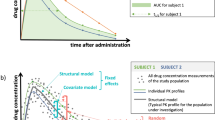Summary
The pharmacokinetics of mofarotene were investigated in mice, rats and dogs following single intravenous and oral administrations. Healthy volunteers were also given a single oral dose of 300 mg mofarotene. The data indicate a similar disposition for mofarotene in all species studied: low clearance consistent with a high bioavailability following oral dosing, and large volume of distribution indicating an extensive tissue uptake. Also in vitro in liver microsomes, the values for intrinsic clearance were in all species within a 2-fold range. The dog, however, tended to exhibit, both in vitro and in vivo, the lowest clearance. Although (due to the lack of protein binding data) a direct prediction of the in vivo clearance from in vitro data was not possible, the experiments with liver microsomes did provide a clear insight into the rate of elimination of mofarotene in vivo in the different species studied including man.
Similar content being viewed by others
References
Eliason J., Teelmann K., Crettaz M. (1990): New retinoids and the future of retinoids in skin cancer. In: Marks R. (Ed) Retinoids in cutaneous malignancy. Oxford, Blackwell, pp. 157–170.
Hartmann D., Eliason J., Teelmann K., Kaufmann F., Klaus M. (1993): Ro 40-8757, a novel arotinoid with anti-cancer activity. In: Livrea M.A., Packer L. (Eds) Retinoids, progress in research and clinical applications. New York, Marcel Dekker.
Eliason J., Kaufmann F., Tanaka T., Tsukaguchi T. (1993): Anti-proliferative effects of the arotinoid Ro 40-8757 on human cancer cell lines in vitro. Br. J. Cancer, 67, 1293–1298.
Ba B., Coassolo Ph. (1991): Personal communication.
Von Bahr C., Groth C.-G., Jansson H., Lundgren G., Lind M., Glaumann H. (1980): Drug metabolism in human liver in vitro: establishment of a human liver bank. Clin. Pharmacol. Ther., 27, 711–725.
Omura T., Sato R. (1964): The carbon monoxide-binding pigment of liver microsomes. J. Biol. Chem., 239, 2379–2385.
Smith P.K., Krohn R.I., Hermanson G.T., et al. (1985): Measurement of protein binding using bicinchronic acid. Anal. Biochem., 150, 76–85.
Boxenbaum H. (1980): Interspecies variation in liver weight, hepatic blood flow, and antipyrine intrinsic clearance: extrapolation of data to benzodiazepines and phenytoin. J. Pharmacokinet. Biopharm., 8, 165–176.
Author information
Authors and Affiliations
Rights and permissions
About this article
Cite this article
Vallès, B., Ba, B., Wyss, R. et al. In vivo and in vitro kinetics of mofarotene in mouse, rat, dog and man. Eur. J. Drug Metab. Pharmacokinet. 20, 49–53 (1995). https://doi.org/10.1007/BF03192288
Received:
Issue Date:
DOI: https://doi.org/10.1007/BF03192288




